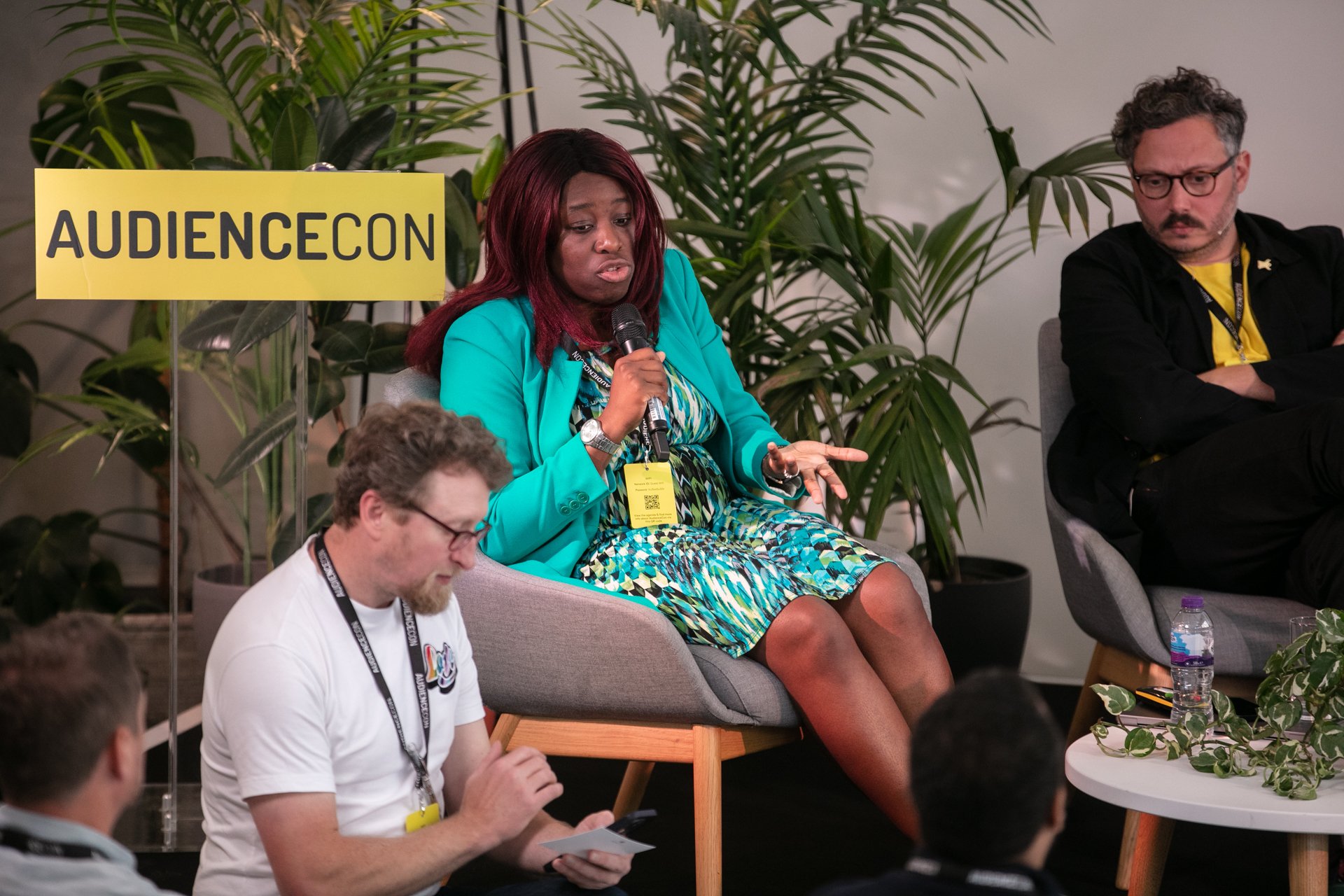Harmonizing data and action: Unleashing the power of audience intelligence in the music industry
As a great man once said, if music be the food of love, play on. These days, we find that music is not just about love and connection, it’s also rich with data and creative opportunities for marketers that know how to tune in.
At AudienceCON 2023 we were honored to chat to Christine Osazuwa – Founder of Measure of Music and Chief Strategy Officer at Shoobs – about how she puts audiences at the heart of her strategy. With over 15 years of experience in the music industry, Christine has held roles across the music industry including ticketing sites, merch sales, venue promotion and working for labels.
Here are the key takeaways from Christine’s hugely valuable session in conversation with David Boyle, an audience strategist with experience in the music industry.
Start with the basics
With so many incredible artists launching ground-breaking campaigns on social media (we’re looking at you, Taylor Swift), it can be easy to get swept away by grand marketing notions. But Christine is a huge advocate for making sure you’ve got the basics right before you start brainstorming your biggest campaigns.
Talking about her time working for a major label, Christine said: “It was a segmentation project to look at the top audiences for different artists, and I would say, we should focus all our attention on this core fan base before we do any marketing to anyone else. And I would get pushback, where someone will say, ‘if they were really a fan they would listen on day one.’”
But of course, consumers aren’t just waiting on the edge of their seats for the next thing marketing has to promote. “To prove the point, I ended up segmenting the audience of people that had and had not listened,” said Christine. “I learned that people who have not listened also happen to listen to a lot of Disney music, because they’re parents, and they haven’t listened to that album because they have lives.”
The key for marketers is to step back and look at the big picture. Before going big and trying to target millions of people, it’s important to tap into your owned audiences.
“One thing I will say is that email is still very much king. And the reason why email is incredibly important still [is] because I've had the same email address since 2004 and do you know how many times I've changed social media sites? So, step one, make sure you figure out some way to get someone's email address because trying to build from scratch continuously is really challenging,” said Christine.
Use your subscribers, pay attention to your organic social media channels, and understand your audiences from the ground up. Paying attention to the basics – as well as investing in the right audience intelligence tools – can be hugely beneficial in shaping your perspective and your overall marketing strategies.
Look beyond your own market
An important step in developing your audiences, and understanding the potential of both new and existing ones, is to gain that deep understanding of who they are and what they want. Christine’s experience organizing shows and working directly with fans has provided much needed perspective into the on-the-ground reality, for both artists and fandoms.
For example, she discussed the impact of early 2000s and 2010s music culture, where fandoms played a role in cultivating the reputations of labels, including Fueled By Ramen, the label behind many of the era’s biggest emo and punk bands including Panic! At The Disco and Paramore.
“They built a name for themselves where people just listened to anything they released, because they were assigned to that label,” said Christine. “That is the type of audience development work that was magical right? Imagine just putting out an album and people being like ‘I’m going to go check that out’. Because they knew their audience, they built the trust of their audience, it was very much grassroots and translating that digital / offline, is where the sweet spot tends to happen in a lot of industries.”

Being able to cross-reference her on-the-ground experience with data gave her the confidence to look beyond typical audiences and understand global impact and potential complexities for campaigns. Talking about her role working at Warner Music Group as Global Director of Data & Insights, Christine said: “What I was really doing was figuring out how music worked around the world, how music broke around the world, how to market music around the world. It's really interesting because the music industry can be very US centric.”
Through this role, Christine was able to gain deeper insight into 40 different territories and understand things like behavioral patterns, most influential regions, the biggest growth opportunities and how music disseminates in these different places. Understanding these complexities in different markets allows marketing teams to create data-centered campaigns that lead to what looks like an overnight success, but actually involves a lot of research and consumer insight to make it happen. But most importantly, “audiences don’t care about borders”.
Embrace data streams to unlock creativity
As an industry, music benefits from multiple streams of data that can build out audience understanding for artists, labels, and venues. However, according to Christine, much of the data is incredibly siloed.
“It’s kind of like one big conglomerate company that never speaks to one another. Your streaming happens on Spotify and Apple and YouTube they have that data, then your ticket sales happen on Ticketmaster, and they have that data, then your merch sales might happen on your website, so you have that data, and then your physical album sales happen in stores and your label has that data”, said Christine.
While this presents a challenge for artists and labels looking to capitalize on these various data streams, Christine highlights the importance of wrangling that data, as it represents a large chunk of the marketing narrative and can show you the path to reaching your audience in new and creative ways. It can also offer huge potential for the way the music industry develops and nurtures new genres and sounds.
That said, Christine was careful to stress that data is not the be-all-and-end-all. “A level of skepticism is really important because you know we're not selling toothpaste, like we're selling someone's career, someone’s stories and someone's life,” said Christine. “[People] come to me, and they say ‘we're going to predict a hit song’… I have had plenty of meetings with artists and managers and at no point have I ever thought, let me tell you how to write your song. What I am going to say is let me tell you how to find your audience. Let me tell you how to do this marketing. Let me tell you what territories will be receptive”.
It's all about finding the right balance between data and creativity, as well as being responsible with data. For her work with Shoobs, Christine has focused on promoting black music, and depending on things such as AI to produce music or run campaigns puts the music industry at risk of creating more of the same. “You can’t make new music by looking at past performance only, even if [someone] with [formula for] the most brilliant hit song, that formula is never going to be an afro beat song, a Rosalia song, a Bad Bunny song. It’s probably going to be a lovely Britney Spears song, and do we want art to just be an exact derivative of everything we've had before?”
Learn from other industries
Taking the time to think outside-the-box and understanding how other industries can work is beneficial for any data or marketing expert, at any level. Christine specifically pointed to travel as an aspirational industry that finds ways to work around unlocking data streams. “When you're thinking about other industries, you're thinking about all the ways you have to supplement or circumvent different things,” she said.
“[What I thought] was really cool and a brilliant move is travel. Travel started packaging up hotels and cars and flights, and all kinds of things together, and I’m like ‘oh, that's smart’. Because obviously you know when they're traveling, where they're staying, how long they're staying, what their budget is, what they decided they want to spend their money on and what they find valuable… all of a sudden you have like, the fullest picture of a person that you probably could ever have,” said Christine.
The travel industry has been able to consolidate their vast data streams into a strategy that the music industry should do, according to Christine. Citing British Airways as a specific example, “British Airways don’t have hotels, but they partner up with hotels. British Airways doesn't own car rental for the country… they all saw the inherent value in bringing all these things together. They managed to piece it together in a way that gives the whole picture, and I’m sure providing much better experiences for the actual audience that they're reaching.”
Collaboration is the key here. If the music industry is able to come together and be more transparent in the way they share and work with the data available, it could add huge value for artists and fans across the chain.
The importance of fans
Last but most certainly not least, Christine highlighted the importance of having fans on your team, no matter your industry: “You have to have people that are really, really passionate and excited about whatever it is that you're selling.”
This passion can be both a blessing and a curse. “They're going to tell you the truth, they're going to tell you when your ideas are stupid. They’re going to see the backlash is coming before you have the chance to do so. If you don't have those people on the team, then you lose a lot of the authenticity.”
As we recently discussed in an article for Contagious, pop culture and the fans that spark it can shape your next campaign supernova. The recent 1989 (Taylor's Version) release was an undoubtedly fan-centric moment. The campaign involved creating a virtual vault for fans to crack in order to access four new songs from the forthcoming re-release. When people Googled Taylor Swift, a vault appeared on-screen, asking fans to solve a puzzle. Swifties were able to crack the vault in less than 24 hours, clearly demonstrating the power of fandom.
TL;DR – The key takeaways
For the time-pressed among us, here’s a quick recap of everything we learned from this incredible session.
- Start with the basics to reach your core audience, before you go bigger
- Look beyond your own market, your biggest fans do not care about borders
- Embrace data streams, taking the time to break down silos can have major impact
- Learn from other industries, they might be able to show you how to improve your own
- The importance of fans, they are the fuel that will drive your campaigns, and your brand, forward
Christine Osazuwa delivered a must-see presentation at AudienceCON on how she puts audiences at the heart of her strategy. Watch it here in its entirety.





